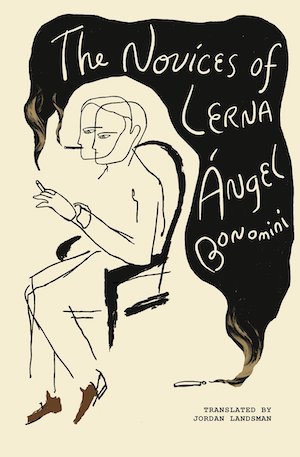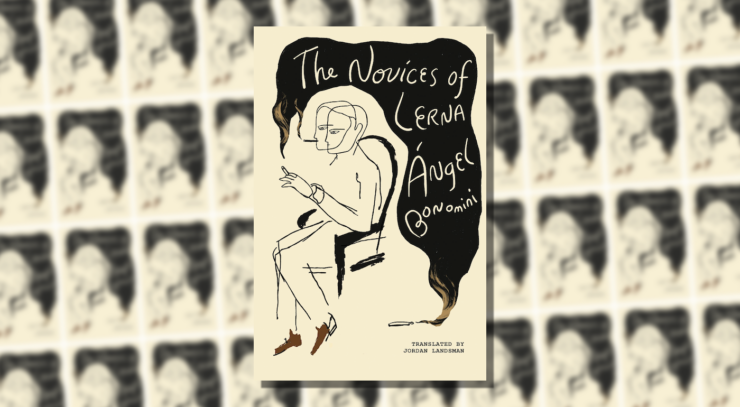For many an academic, the prospect of a six-month fellowship in central Europe would be an alluring prospect indeed. That’s the offer that Ramón Beltra, the narrator of the title work of Ángel Bonomini’s The Novices of Lerna, considers and accepts on the story’s first page. The first sign that something might be a little strange comes via an unexpected request from the home of the fellowship, the University of Lerna. Our hero must provide them with what he describes as, via Jordan Landsman’s translation, “a frankly disconcerting report of my physical characteristics.”
That’s what’s known as a red flag. Unfortunately, Ramón does not heed his sense that something is very wrong here and makes his way from Buenos Aires to Lerna, where he’s picked up at the airport by his doppelgänger. It might be more accurate to say “one of his doppelgängers,” however, because all of the fellows at this space are virtually identical to one another—despite hailing from all over the world. All told, there are 24 of them.
Ramón quickly learns the rules governing the fellowship, which include the fellows occasionally swapping rooms, maintaining identical attire and haircuts, and refraining from gestures that might identify them. The reason behind this remains a mystery, as Ramón explains:
The university’s objective in gathering a group of individuals with identical physical characteristics was kept completely secret. Everyone was allowed to consider, judge, assess, and interpret the fact in any way they pleased, but the university reserved the right not to communicate the objective of the ‘project’ to any individual fellow or group.
That’s a strange enough premise, but “The Novices of Lerna” has a few more twists to take before reaching its conclusion. (The title story takes up the first third of this volume, the first work of Bonomini’s to be translated into English.) Soon, Ramón notices that some of his cohorts are going missing. Before long, it becomes clear that a kind of pandemic is sweeping through the fellowship, decimating its members.
Buy the Book


The Novices of Lerna
What makes this story especially unsettling are the possible interpretations of what’s going on. It’s possible to read Bonomini’s story as a satire of academic hubris — namely, that the administrators running this fellowship are seeing their plans upended because of disease, a factor that they could neer have anticipated. One could read this as a metaphysical yarn; after all, meeting one’s doppelgänger is said to end badly, so what would mean for literal dozens of doppelgängers to come into contact? And it’s possible to take a more conspiracy-minded approach: What if the malady felling the fellows is part of the fellowship itself? That Bonomi leaves the door open to all three (at the very least) is magnificently unsettling.
“The Novices of Lerna” also sets the tone for the shorter stories that follow it, both in terms of the use of narrative ambiguity and the striking ways in which Bonomini juxtaposes the quotidian (like, say, Ramón starting a relationship with a flight attendant en route to Lerna) to the surreal (doppelgängers in jumpsuits). If there’s a running theme in this collection, it’s the malleability of identity. In the story “The Bengal Tiger,” for instance, Bonomini centers the story around a man, a woman, and a tiger, and constantly reshuffles their positions relative to one another:
The tiger looks at himself in a mirror and sees the man’s reflection instead of his own. He eats him up. The woman looks at herself in a mirror, but rather than seeing her own reflection, there’s a hungry tiger staring at her.
The haunting “Aromatic Herbs” begins with its narrator musing on dreams and ends with him in an ambiguous state, possibly deceased but unable to proceed into any kind of afterlife. And two characters in “The C.C.C.” becomes convinced that they’re being replicated en masse—and that a chain establishment may be behind the whole thing. Bonomini excels at depicting characters experiencing paranoia and alienation, but in some cases their paranoia turns out to be utterly justified, adding another wrinkle to these genre-spanning stories.
Bonomini was a contemporary of Adolfo Bioy Casares, Silvina Ocampo, and Jorge Luis Borges; an excerpt from a letter from Bioy Casares to Bonomini about Borges being “dazzled” by “The Novices of Lerna” can be found on the back of my edition of this book. And it’s not too much of a reach to suggest that Bonomini’s work sits neatly beside theirs on the shelf, finding a compelling balance of heady high concepts with pulp thrills. As a 2018 article in Infobae pointed out, journalist Marcelo A. Moreno dubbed Bonomini a “maestro secreto” in the aftermath of Bonomini’s 1994 death. This volume is a welcome addition to Argentinian literature in translation—and to Weird fiction the world over.
The Novices of Lerna is published by Transit Books.










